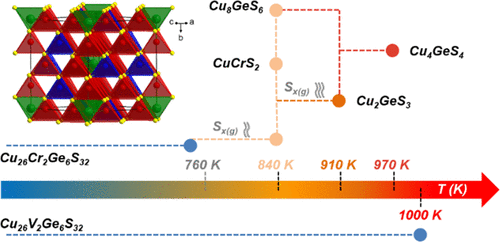当前位置:
X-MOL 学术
›
Chem. Mater.
›
论文详情
Our official English website, www.x-mol.net, welcomes your
feedback! (Note: you will need to create a separate account there.)
Thermal Stability of the Crystal Structure and Electronic Properties of the High Power Factor Thermoelectric Colusite Cu26Cr2Ge6S32
Chemistry of Materials ( IF 7.2 ) Pub Date : 2020-01-10 , DOI: 10.1021/acs.chemmater.9b04378 Pierric Lemoine 1 , Ventrapati Pavan Kumar 2 , Gabin Guélou 2 , Vivian Nassif 3, 4 , Bernard Raveau 2 , Emmanuel Guilmeau 2
Chemistry of Materials ( IF 7.2 ) Pub Date : 2020-01-10 , DOI: 10.1021/acs.chemmater.9b04378 Pierric Lemoine 1 , Ventrapati Pavan Kumar 2 , Gabin Guélou 2 , Vivian Nassif 3, 4 , Bernard Raveau 2 , Emmanuel Guilmeau 2
Affiliation

|
A complete study on the thermal stability of the crystal structure and electrical properties, as well as on the phase decomposition, of the high-performance thermoelectric colusite Cu26Cr2Ge6S32 is presented. A combination of results from differential scanning calorimetry, thermogravimetric analysis, in situ neutron powder diffraction, and Seebeck coefficient and electrical resistivity temperature cycling experiments show that the high thermoelectric performance colusite Cu26Cr2Ge6S32 is stable at least up to 700 K in a nonoxidative atmosphere. A superficial sulfur loss without phase decomposition is observed above ≈760 K, leading to a progressive increase of both electrical resistivity and Seebeck coefficient. The colusite phase, Cu26Cr2Ge6S32, starts to decompose above 830 K into Cu8GeS6 and CuCrS2 phases. This leads to a Ge enrichment of the colusite phase (i.e., decrease of the Cu/Ge ratio). This initial decomposition step is followed by a second one above 880 K, related to the structural modification from the cubic structure of colusite into the monoclinic Cu2GeS3 structure. Above 930 K, the colusite Cu26Cr2Ge6S32 phase is fully decomposed. The influence on the crystal structure of the superficial sulfur loss detected a few dozens of degrees before the colusite Cu26Cr2Ge6S32 phase decomposition is discussed and compared to the results obtained on the colusite Cu26V2Ge6S32 phase, stable at least up to 1000 K. A singular thermal evolution of the unit cell parameter of the latter is observed and discussed. Finally, a discussion on the thermoelectric performance optimization by process-induced structural disordering in these two colusite phases is given.
中文翻译:

高功率因数热电堇青石Cu 26 Cr 2 Ge 6 S 32的晶体结构的热稳定性和电子性能
提出了对高性能热电褐煤Cu 26 Cr 2 Ge 6 S 32的晶体结构和电学性质的热稳定性以及相分解的完整研究。差示扫描量热法,热重分析,原位中子粉末衍射,塞贝克系数和电阻率温度循环实验的结果相结合,表明具有高热电性能的堇青石Cu 26 Cr 2 Ge 6 S 32在非氧化气氛中至少稳定在700 K以下。在≈760K以上观察到没有相分解的表层硫损失,导致电阻率和塞贝克系数的逐渐增加。褐铁矿相Cu 26 Cr 2 Ge 6 S 32在830 K以上开始分解为Cu 8 GeS 6和CuCrS 2相。这导致了软锰矿相的Ge富集(即Cu / Ge比的降低)。在此初始分解步骤之后,进行第二个高于880 K的分解步骤,该步骤涉及从褐铁矿的立方结构到单斜晶Cu 2 GeS 3的结构改性。结构体。930 K以上时,褐云母Cu 26 Cr 2 Ge 6 S 32相被完全分解。讨论了在褐铁矿Cu 26 Cr 2 Ge 6 S 32相分解之前几十度检测到的表面硫损失对晶体结构的影响,并将其与在褐铁矿Cu 26 V 2 Ge 6 S 32上获得的结果进行了比较。相,至少在1000 K以下稳定。观察并讨论了后者的晶胞参数的奇异热演化。最后,讨论了在这两个褐铁矿相中通过过程诱导的结构无序优化热电性能。
更新日期:2020-01-10
中文翻译:

高功率因数热电堇青石Cu 26 Cr 2 Ge 6 S 32的晶体结构的热稳定性和电子性能
提出了对高性能热电褐煤Cu 26 Cr 2 Ge 6 S 32的晶体结构和电学性质的热稳定性以及相分解的完整研究。差示扫描量热法,热重分析,原位中子粉末衍射,塞贝克系数和电阻率温度循环实验的结果相结合,表明具有高热电性能的堇青石Cu 26 Cr 2 Ge 6 S 32在非氧化气氛中至少稳定在700 K以下。在≈760K以上观察到没有相分解的表层硫损失,导致电阻率和塞贝克系数的逐渐增加。褐铁矿相Cu 26 Cr 2 Ge 6 S 32在830 K以上开始分解为Cu 8 GeS 6和CuCrS 2相。这导致了软锰矿相的Ge富集(即Cu / Ge比的降低)。在此初始分解步骤之后,进行第二个高于880 K的分解步骤,该步骤涉及从褐铁矿的立方结构到单斜晶Cu 2 GeS 3的结构改性。结构体。930 K以上时,褐云母Cu 26 Cr 2 Ge 6 S 32相被完全分解。讨论了在褐铁矿Cu 26 Cr 2 Ge 6 S 32相分解之前几十度检测到的表面硫损失对晶体结构的影响,并将其与在褐铁矿Cu 26 V 2 Ge 6 S 32上获得的结果进行了比较。相,至少在1000 K以下稳定。观察并讨论了后者的晶胞参数的奇异热演化。最后,讨论了在这两个褐铁矿相中通过过程诱导的结构无序优化热电性能。











































 京公网安备 11010802027423号
京公网安备 11010802027423号